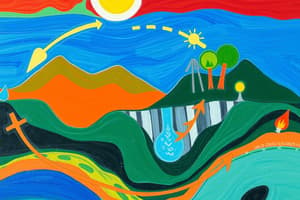Podcast
Questions and Answers
How does matter move through the biosphere?
How does matter move through the biosphere?
Unlike the 1-way of energy, matter is recycled within and between ecosystems.
What are biogeochemical cycles?
What are biogeochemical cycles?
The closed loops that allow elements to pass from 1 organism to another and among parts of the biosphere, powered by the flow of energy.
How does the water cycle flow through the biosphere?
How does the water cycle flow through the biosphere?
Water continuously moves between the oceans, the atmosphere, and land, sometimes outside living organisms and sometimes inside them.
What are nutrients?
What are nutrients?
What is the importance of the main nutrient cycles?
What is the importance of the main nutrient cycles?
What are the 4 types of processes that cycle matter through the biosphere?
What are the 4 types of processes that cycle matter through the biosphere?
By what 2 processes is water cycled from land to the atmosphere?
By what 2 processes is water cycled from land to the atmosphere?
What is nitrogen fixation?
What is nitrogen fixation?
What is denitrification?
What is denitrification?
Describe 1 way in which water from the ocean may make 1 complete cycle through the atmosphere and back to the ocean.
Describe 1 way in which water from the ocean may make 1 complete cycle through the atmosphere and back to the ocean.
How does nutrient availability relate to the primary productivity of an ecosystem?
How does nutrient availability relate to the primary productivity of an ecosystem?
Why do living organisms need nutrients?
Why do living organisms need nutrients?
Based on your knowledge of the carbon cycle, what do you think might happen if humans were to continue to clear and burn vast areas of forests for building?
Based on your knowledge of the carbon cycle, what do you think might happen if humans were to continue to clear and burn vast areas of forests for building?
What is a limiting nutrient?
What is a limiting nutrient?
Explain how a nutrient can be a limiting factor in an ecosystem.
Explain how a nutrient can be a limiting factor in an ecosystem.
How is fertilizer runoff related to algal booms?
How is fertilizer runoff related to algal booms?
Study Notes
Overview of Matter and Energy Flow
- Matter is recycled within and between ecosystems, unlike the one-way flow of energy.
- Biogeochemical cycles serve as closed loops that facilitate the transfer of elements among organisms and across biospheric components, powered by energy flow.
Water Cycle
- Water constantly moves between oceans, the atmosphere, and land, involving both living organisms and the environment.
- Ocean water evaporates, transforms into water vapor, and precipitates back to Earth's surface.
Nutrient Importance
- Organisms require nutrients to build tissues and perform vital life functions.
- Nutrients cycle through biogeochemical processes, with carbon, nitrogen, and phosphorus being critical for sustaining life.
Types of Matter Cycling Processes
- Four major processes cycle matter through the biosphere: the water cycle, carbon cycle, nitrogen cycle, and phosphorus cycle.
Water Cycling Processes
- Water transitions from land to the atmosphere via chemical processes (like evaporation) and physical processes (like transpiration).
Nitrogen Cycle
- Nitrogen fixation occurs when specific bacteria convert nitrogen gas into ammonia.
- Denitrification is the process where certain bacteria convert nitrates back to nitrogen gas, releasing it into the atmosphere.
Nutrient Availability and Ecosystem Productivity
- Primary productivity may be limited by nutrient availability when sunlight and water are abundant.
- A limiting nutrient restricts productivity; if it's in short supply, ecosystem functions slow or cease.
Impact of Human Activity
- Continuous deforestation and burning for construction could deplete forests, leading to increased air pollution.
Fertilizer Runoff and Algal Blooms
- The process of mining phosphorus, converting it to fertilizer, and applying it to crops results in excess runoff into waterways.
- This nutrient runoff can provoke algal blooms, disrupting aquatic ecosystems.
Studying That Suits You
Use AI to generate personalized quizzes and flashcards to suit your learning preferences.
Description
Explore the essential concepts of Chapter 3.4 on the cycles of matter with these flashcards. Understand how matter is recycled in ecosystems and gain insights into various biogeochemical cycles like the water cycle. Test your knowledge and reinforce your understanding of these crucial ecological processes.




